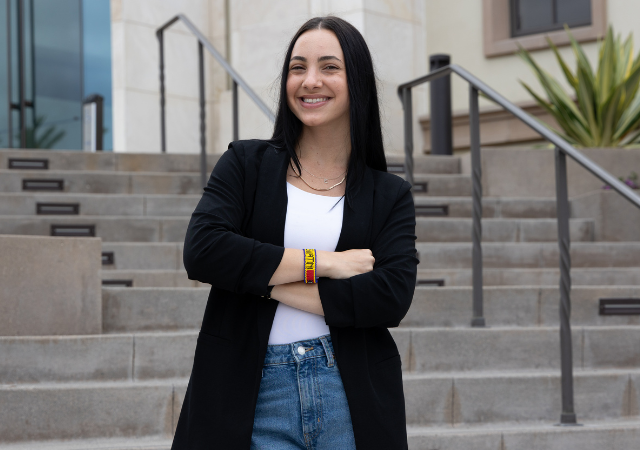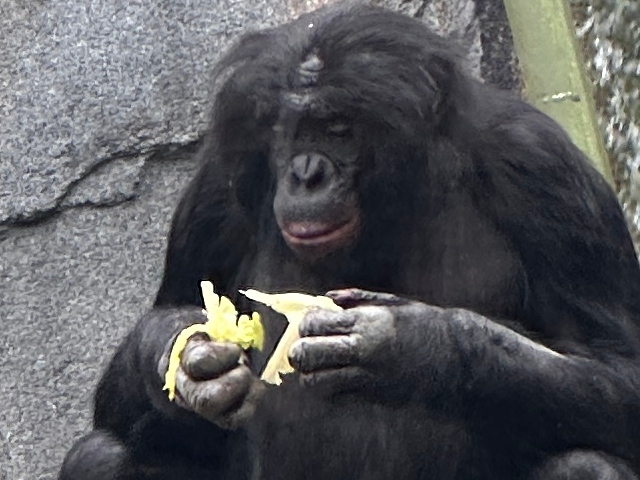Name Changes Aim to Build a More Inclusive USD Campus
The University of San Diego’s decision to change names on multiple buildings and spaces on campus gained more visible recognition on Wednesday.
On April 17, the Canadian Feast Day of St. Tekakwitha, the USD community was invited to attend the daily 12:15 p.m. Mass in Founders Chapel, followed by a program and refreshments at the nearby Plaza de Colachis to celebrate the name changes. Photo renderings of the new names were on display, but the official changes won’t happen until this fall.
The name changes are: Saints Tekakwitha and Serra Hall (formerly just Serra Hall) in honor of St. Kateri Tekakwitha, the first Native American Catholic saint and St. Junipero Serra; Mata’yuum Crossroads (formerly Mission Crossroads), which means “gathering place” in the Kumeyaay language; the Student Life Pavilion’s Plaza Mayor will now honor St. Teresa of Calcutta and Plaza Menor will recognize Francis Xavier Nguyễn Văn Thuận, a Vietnamese Cardinal and social justice advocate that Pope Francis named as Venerable in 2017.
Following Mass, the program consisted of comments by USD President James T. Harris III; a Kumeyaay Nation land acknowledgement and comments from Associated Students President Natasha Salgado; comments from American Indian Student Organization (AISO) Chairman, Associated Students Senator and Pechanga Band of Luiseño Indians member P.J. (Patrick) Murphy; and Student Affairs Vice President Carmen Vazquez.
“This is a great victory for inclusion and diversity on our campus,” Murphy said. “This change comes after a push from American Indian students — especially the last two years by AISO members — so I thank you for your efforts. I also want to thank other student organizations, faculty, staff and administrators who we gained alliances with to help voice our concerns that much louder. It was all of you who got me a seat at the table with the president and created the opportunity for dialogue to happen.”
President Harris complimented a cross-section group of campus leaders — Murphy, Salgado, Vazquez, Graduate Student Council President Briana Clark, Monsignor Daniel J. Dillabough, USD Tribal Liaison and Professor of Practice in Ethnic Studies, Perse Lewis; and Executive Director of University Design and Collections’ Mary Whelan — who worked through logistics to render a suitable solution.
“I brought this group together last fall to help me think through the issues on campus and to determine how we recognize our Catholic heritage and the rich history of the Kumeyaay Nation together,” Harris said.
He mentioned that while he attended the Institute for Civil Civic Engagement’s annual civility conference on campus earlier Wednesday, there was a comment made that made a connection to this announcement. “It was said that people tend to come into a conversation expecting a win or a loss. Some people have asked if this is a win or a loss and I believe it is a victory for everyone. It’s a victory for collaboration, a victory for mutuality, a victory for compromise and it’s a big victory for inclusion and diversity on our campus. I’m proud of where we stand today.”
Harris also mentioned a few additional changes that were not mentioned in the campuswide announcement earlier this month. The university will remove the word “mission” from its parking structure near the main entrance and call it the Main Parking Structure. The Missions A and B residence halls will now go by Valleys A and B.
Salgado said that providing a land acknowledgement statement — USD's campus rests on Kumeyaay land — is “one piece of a larger puzzle we’ve been building at USD to make visible the Kumeyaay and, more generally, Native Americans’ historical and contemporary issues, perspectives and experiences. These efforts have led to stronger relationships with the tribes in this region, increased access for Native American students, made for a better educational experience for those who choose to attend our school and makes a more dynamic, intellectual campus community.
“For those of us gathered here today,” she continued, “I would like for us to not only recognize Indigenous people in their territory, but also acknowledge our place as guests on Kumeyaay lands. Native American scholars call on universities to support the nation-building activities of tribes, which ultimately means a commitment to their sovereignty and self-determination. These name changes are an attempt to create a campus that does more than just acknowledge social injustices, one that can commit to fulfilling its role as a Changemaker Campus at the institutional level.”
Murphy’s reaction to the work and, ultimately, the decision was priceless: “I was excited and nervous when I got the opportunity. Excited because I was seeing the process continue and to see all of the hard work formulate into this opportunity to move further. But I was nervous because of how many voices I was representing. This work was not started by me. When I came to the university, I heard it had been going on years before me so I wanted to be sure to represent the communities before me and the students of my organization very well. I think the name change, the duality, really speaks to the inclusion and diversity mantra that this university shows. It can pay respects to the Indigenous people of this land as well as pay respects to the Catholic religion of this university. … This is a form of reconciliation and how we can live together and how we can move forward in the future. I’m graduating in May and I’m happy to see the name change happen in my time. My only hope is that this is the first step of building a more inclusive campus.”
The program closed with Vazquez offering a mindful, hopeful message.
“Much has been said about how we got here and the struggle that it took. What my experience has been in this is a journey and it is a process. Early on, the students, Natasha and PJ came to me and said 'what do we need to do to prepare for the meeting? We want to make sure we’re ready.' I said two things to them: 'Please come with an open heart and an open mind.' I know at the university we focus on the intellectual in the mind, but I want to bring us back to the Religious of the Sacred Heart. Their symbol is the heart. I believe it’s the heart and the mind that connected the opportunity for consensus and mutuality. … When the heart and mind are connected all is possible.”
— Ryan T. Blystone
Contact:
USD News Center
news@sandiego.edu
(619) 260-4681



